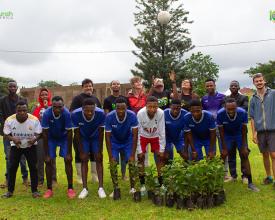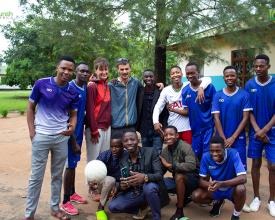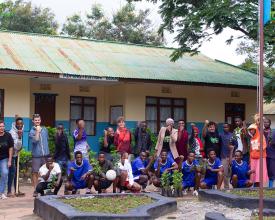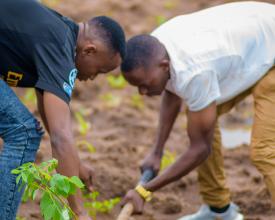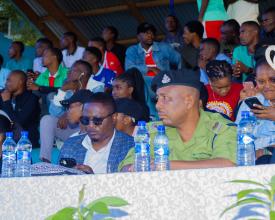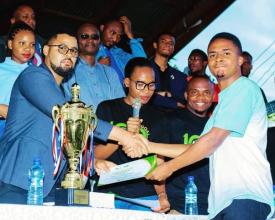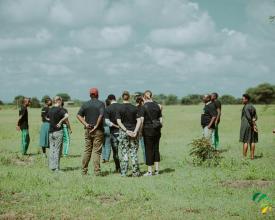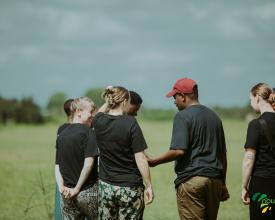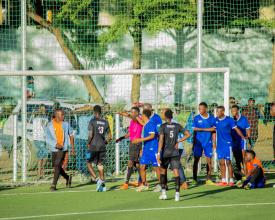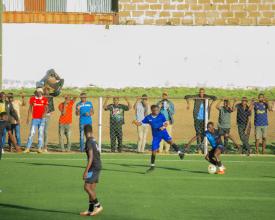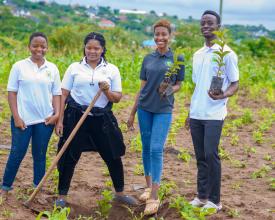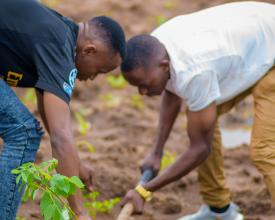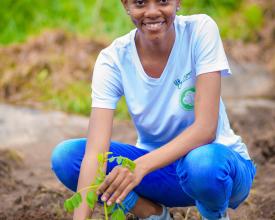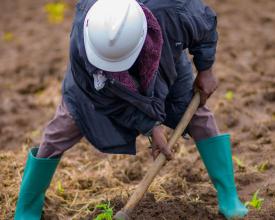
Un objetivo, 100 árboles - Jugamos, plantamos abogando por la gestión medioambiental de los jóvenes en Tanzania

La campaña "UN GOL 100 ÁRBOLES" JUGAMOS, PLANTAMOS es una iniciativa dinámica dirigida a los jóvenes de universidades y colegios, que utiliza el fútbol como una poderosa herramienta para promover la conservación del medio ambiente. La campaña vincula la emoción del fútbol con el objetivo de plantar árboles, animando a los estudiantes a marcar goles tanto en el campo como para el planeta. Por cada gol marcado en partidos o torneos, se establece el compromiso de plantar 100 árboles por tanto. Este planteamiento no sólo fomenta el trabajo en equipo y la competición, sino que también sensibiliza sobre cuestiones medioambientales, capacitando a los estudiantes para contribuir activamente a un futuro más verde. Mediante actos de plantación de árboles y colaboraciones con clubes de fútbol universitarios, la campaña inspira una cultura de sostenibilidad y responsabilidad entre los jóvenes.
Contexto
Défis à relever
La campaña "One Goal 100 Trees" pretende abordar los retos medioambientales y educativos. La comunidad carece de educación sobre cómo preservar el medio ambiente, nuestra campaña se centra en abordar los problemas medioambientales específicos de la comunidad, en relación con la deforestación y el uso de leña para energía, nuestro objetivo es educar a la comunidad sobre estas prácticas negativas para el medio ambiente y proporcionar formas alternativas de uso de la energía, proporcionamos especies específicas de árboles como fuente de energía y algunos árboles nativos para la captura de carbono.
Ubicación
Procesar
Resumen del proceso
Los componentes básicos de esta solución están estrechamente relacionados, y cada uno de ellos refuerza a los demás para lograr resultados satisfactorios. La colaboración y las asociaciones sientan las bases y proporcionan el apoyo y los recursos necesarios para toda la iniciativa. La evaluación del paisaje garantiza que las especies seleccionadas se adapten bien al entorno, lo que aumenta las probabilidades de éxito de la restauración. El fútbol es una poderosa herramienta de compromiso, que atrae a los jóvenes y fomenta una amplia participación en los esfuerzos de conservación. Por último, el seguimiento y la evaluación se integran en todo el proceso, lo que permite una mejora continua y garantiza la sostenibilidad a largo plazo. Juntos, estos componentes crean una estrategia cohesiva y eficaz que aprovecha el compromiso de la comunidad, la evaluación científica y el aprendizaje continuo para impulsar una conservación medioambiental impactante.
Bloques de construcción
Colaboración y asociaciones para la educación medioambiental
Este bloque de construcción se centra en implicar a universidades, colegios y socios locales en la educación medioambiental y los esfuerzos de conservación. Colaboramos con clubes y equipos de fútbol de los campus para promover la concienciación sobre el cambio climático y la conservación de especies amenazadas. Aprovechando estas asociaciones, proporcionamos a las comunidades los conocimientos y herramientas necesarios para combatir el cambio climático. La colaboración se extiende a las organizaciones medioambientales locales, que ofrecen apoyo técnico a las comunidades. Este enfoque interconectado es vital para el éxito de nuestra campaña, que moviliza recursos, impulsa la participación y amplifica el impacto de la campaña a través de los esfuerzos colectivos de instituciones educativas, grupos ecologistas, organismos gubernamentales, estrellas del fútbol, personas influyentes y empresas patrocinadoras.
Factores facilitadores
La participación temprana de los socios es crucial para el éxito de este componente básico. Al involucrarlos desde el inicio del proyecto, los socios comprenden claramente los objetivos y pueden contribuir eficazmente con recursos, como proporcionar personal para las campañas de fútbol. Esta inclusión temprana fomenta un sentimiento de apropiación y compromiso entre los socios, reforzando su apoyo y garantizando el cumplimiento de los objetivos del proyecto.
Lección aprendida
Una lección clave aprendida es la importancia crítica de la colaboración en los proyectos de conservación medioambiental. El éxito depende de la participación de todos los niveles de la comunidad, desde los jóvenes y las universidades hasta los socios locales. Asegurarse de que estos grupos se sientan verdaderos colaboradores fomenta un sentimiento de propiedad y compromiso, esencial para la sostenibilidad del proyecto.
Evaluación del paisaje para el éxito de las especies
El objetivo de este bloque es realizar evaluaciones exhaustivas del paisaje en los terrenos propiedad de facultades y universidades. Evaluando las condiciones ambientales, podemos determinar qué especies son las más adecuadas para prosperar en esas zonas. Este cuidadoso proceso de selección garantiza mayores tasas de éxito en la plantación y contribuye a unos esfuerzos de conservación más sostenibles. La evaluación del paisaje sirve de base para estrategias de plantación eficaces, adaptando la selección de especies a las características ecológicas específicas del terreno, lo que en última instancia conduce a ecosistemas más resistentes.
Factores facilitadores
Entre los factores clave para el éxito figuran contar con sólidos conocimientos técnicos medioambientales dentro del equipo y aprovechar nuestras asociaciones con universidades para acceder a los terrenos a evaluar. Estas asociaciones proporcionan el apoyo y los recursos necesarios para llevar a cabo evaluaciones exhaustivas, garantizando que las especies seleccionadas se adapten bien a las condiciones específicas de cada lugar, lo que es fundamental para el éxito a largo plazo de los esfuerzos de plantación.
Lección aprendida
Una de las principales lecciones aprendidas es que no todas las especies arbóreas pueden prosperar en la misma región. Realizar evaluaciones del terreno es esencial para comprender las condiciones medioambientales únicas de cada zona. Este conocimiento nos permite seleccionar las especies que tienen más probabilidades de éxito, mejorando la eficacia general de nuestros esfuerzos de plantación. Al alinear las especies con sus hábitats ideales, mejoramos la sostenibilidad y el impacto de nuestras iniciativas de conservación.
El fútbol como catalizador de la conservación del medio ambiente
Esta iniciativa aprovecha el gran atractivo del fútbol para implicar a los jóvenes en los esfuerzos de conservación del medio ambiente. Nuestros educadores medioambientales colaboran con estudiantes universitarios, utilizando el fútbol como medio para concienciar a través de carteles, charlas y actos centrados en métodos de restauración. Aprovechando la popularidad del fútbol, hacemos que los problemas medioambientales sean más cercanos y atractivos, inspirando a los estudiantes a adoptar prácticas sostenibles. Este enfoque no sólo educa, sino que también moviliza a los jóvenes para que participen activamente en la conservación, haciéndoles sentirse parte integrante de la solución.
Factores facilitadores
Los factores clave del éxito incluyen la fuerte conexión entre el fútbol y la cultura juvenil, que hace más accesibles los mensajes medioambientales. Los torneos de fútbol crean expectación, fomentan el sentido de comunidad y el compromiso en torno a los temas de conservación. Además, el respeto y la influencia de los clubes de fútbol locales y de los jugadores son cruciales para amplificar el impacto de la campaña, motivando a los jóvenes a participar y a apropiarse de las cuestiones medioambientales.
Lección aprendida
Aprendimos que el fútbol es una poderosa herramienta para conectar a comunidades diversas y promover la inclusión en torno a cuestiones medioambientales. Tiende puentes entre los jóvenes marginados, fomentando un esfuerzo unificado para conservar el medio ambiente. Involucrar a las mujeres jóvenes y a las niñas en estas actividades es crucial para garantizar la inclusión. Utilizando el fútbol, reforzamos las relaciones y el entendimiento mutuo, demostrando que el deporte puede ser una fuerza unificadora en los esfuerzos de conservación.
Seguimiento y evaluación: El núcleo de la conservación sostenible
El seguimiento, la evaluación y el aprendizaje (MEL) son fundamentales para garantizar la sostenibilidad de nuestros esfuerzos de restauración de árboles. Este componente básico nos permite seguir la evolución del crecimiento de los árboles y perfeccionar nuestras estrategias de restauración para obtener mejores resultados. Utilizamos drones para captar imágenes del antes y el después, lo que nos permite comparar visualmente el impacto de nuestro trabajo de restauración. Mediante la evaluación continua de nuestros esfuerzos, podemos hacer ajustes basados en datos que mejoren la eficacia de nuestras iniciativas de conservación.
Factores facilitadores
La integración de sólidas herramientas y sistemas de MEL desde el inicio del proyecto es fundamental para el éxito. Los informes y análisis periódicos son esenciales para adaptar y mejorar nuestras estrategias a medida que avanza la campaña. El acceso a tecnología avanzada, como los drones, mejora nuestra capacidad para supervisar y evaluar los esfuerzos de restauración, proporcionando información detallada que orienta las mejoras en curso.
Lección aprendida
Nos dimos cuenta de que incorporar la MEL a nuestros esfuerzos de conservación es vital para el éxito a largo plazo. Las nuevas tecnologías, como los drones, han mejorado notablemente nuestra capacidad de seguimiento y evaluación del impacto de nuestro trabajo. Estas herramientas no solo proporcionan datos más precisos, sino que también permiten tomar decisiones más informadas, garantizando que nuestros esfuerzos de restauración sean eficaces y sostenibles.
Impactos
La campaña ONE GOAL 100 TREES logró varios resultados clave:
Se plantaron con éxito cientos de miles de árboles en campus y zonas locales, lo que contribuyó a aumentar la cubierta vegetal y mejorar la biodiversidad.
Involucró a más de 12.500 estudiantes en actividades de conservación del medio ambiente
Estableció una sólida colaboración con clubes de fútbol, organizaciones ecologistas de más de 5 de ellos, organismos gubernamentales y personas influyentes locales, creando una red de apoyo que mejoró el alcance y la eficacia de la campaña.
Fomentó la responsabilidad medioambiental entre los jóvenes.
Beneficiarios
- La juventud en las universidades
- Comunidad en torno a los campus de Unversidades y Facultades
Objetivos de Desarrollo Sostenible
Historia
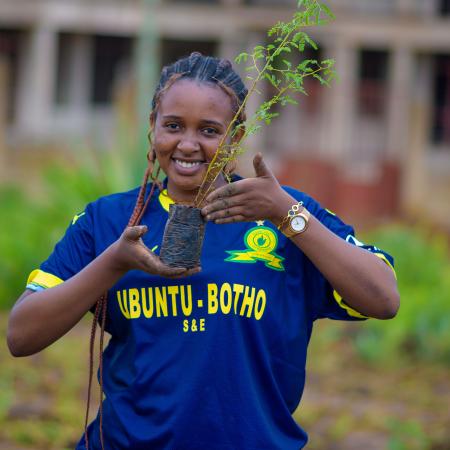
El proyecto nació del deseo de capacitar a los jóvenes para que se hicieran cargo de su entorno. En Tanzania, donde el fútbol es un deporte muy apreciado, observé una preocupante falta de concienciación y compromiso entre los jóvenes en lo que respecta a la gestión medioambiental. Reconociendo el potencial del fútbol como herramienta unificadora e influyente, lanzamos una campaña para conectar con los jóvenes de una forma divertida y significativa.
A medida que avanzaba la campaña, fui testigo de una notable transformación. Jóvenes que hasta entonces habían estado desconectados de las cuestiones medioambientales empezaron a verse a sí mismos como contribuyentes vitales al bienestar de sus comunidades y del planeta. Gracias al fútbol, conseguimos que la educación medioambiental fuera accesible y cercana, lo que provocó un cambio de mentalidad que fue más allá del individuo.
Destacó especialmente una joven, Glory Joseph, estudiante de medicina de Bugando, que se implicó a fondo en nuestra campaña tras participar en uno de los torneos de fútbol. Inspirada por la conexión entre su amor por el juego y su recién descubierta comprensión de la conservación, empezó a liderar iniciativas locales para plantar árboles y educar a sus compañeros en prácticas sostenibles. Su entusiasmo se extendió rápidamente, influyendo en otras personas de su comunidad para que emprendieran acciones similares.
El viaje de esta joven es solo un ejemplo de cómo la campaña no solo ha cambiado las mentalidades individuales, sino que también ha transformado positivamente comunidades enteras. Al asumir su papel de guardianes del medio ambiente, estos jóvenes están impulsando un cambio real y tangible en sus barrios y hogares. Ha sido increíblemente gratificante verlos convertirse en el cambio que desean ver, fortalecidos por un sentido de responsabilidad y esperanza en el futuro.
